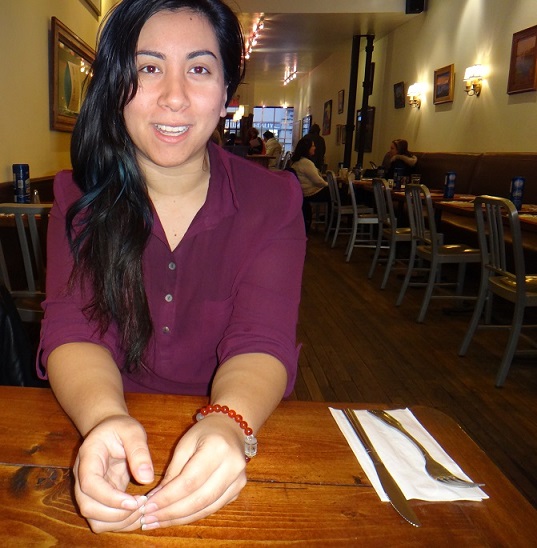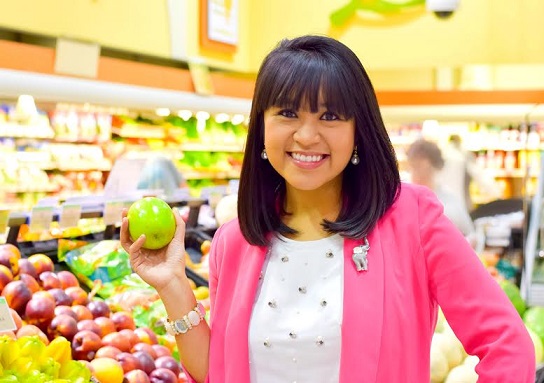Sheena Quizon Gregg: A dietitian nutritionist…and a foodie! (Part 1)
By Christian CatiisWhen we think of the cuisine of the Philippines, certain images come to mind: the fragrant aroma of caramelized garlic and soy sauce in Chicken Adobo, the warmth of a bowl of comforting Pork Sinigang on a chilly winter afternoon, and the addictive salty crunch of Chicharon cascading over freshly made Palabok. In my household, food is never just a meal. It’s what brings together my father’s friends to watch the big Pacquiao fight over bottles of Corona beer. It’s my mother’s famous baked macaroni recipe with sweet banana ketchup adored by her hospital co-workers. It’s piping hot fried Turon that reminds my grandmother of the street vendors back home in Manila. For Filipinos, food is never just a meal; it’s our culture itself.
Filipino food is one of color, taste and richness. But with rising rates of obesity and various ailments, such as high blood pressure and diabetes affecting the Asian/Pacific Islander community, many Asian-Americans, like myself, are taking the initiative of maintaining a healthy diet. But completely leaving out the abundance of salty stews and the juiciness and tenderness of pork found in many classic Filipino dishes would be heartbreaking.
I interviewed Sheena Quizon Gregg, a registered dietician nutritionist from Alabama and a Filipina foodie, to help me figure out the Philippine diet: what to eat and what to eat sparingly!
Sheena received both her Bachelor’s and Master’s degrees in Nutrition and Dietetics from The University of Alabama. She knew she wanted to work in health care, but was not drawn to either medicine or nursing.
“Having a love for food and knowing the role that lifestyle behaviors (including diet) have on our long-term health, I thought that the area of dietetics would be a good fit for me,” she said.
The rest of the interview below:
Chris Catiis: What areas of nutrition are you most interested in and why?
Sheena Quizon Gregg: Diabetes has always been of interest to me due to my significant family history of diabetes on my father’s side and also knowing that the Asian/Pacific Islander ethnic background has a higher susceptibility to Type II diabetes. Working in the state of Alabama with a significant prevalence of obesity, I have had a personal passion for working to treat and prevent both adult and childhood obesity; I have previously served as Chair of the state of Alabama’s Obesity Task Force.
My other focus or specialty area is eating disorders. Working as a dietitian on a college campus, I treat a large number of students with eating disorders, including anorexia, bulimia, and binge eating. Having a personal history with an eating disorder when I was younger, I’ve found this area to be very personal for me.

Some dishes that define Filipino cuisine: Pork Adobo, Pork Sinigang, Pancit Palabok with Chicharon topping, and Turon
CC: Philippine cuisine uses many different types of pork in various dishes such as Sisig, Lechon Kawali and Palabok. And while pork has a great source of protein, it is also very high in cholesterol and saturated fat. Could you give some advice regarding lowering cholesterol levels?
SQG: Having a diet consistently high in saturated fat and cholesterol can lead to a myriad of health issues including obesity, heart disease, and hypertension. I like to encourage my clients to lower their cholesterol intake by removing visible fat from their favorite meats and also including more cholesterol lowering foods in their diet such as fruits, non-starchy vegetables, and other fibrous foods such as oatmeal. Folks can cut back on fat by selecting lean cuts of beef or pork, such as those labeled “loin” or “round.” Removing the skin off poultry can also remove a significant amount of saturated fat. Cooking methods such as baking, broiling, roasting, or stir-frying will add less fat compared to deep frying foods. Cooking ground meat or pork and draining the fat followed by also rinsing the cooked meet can further eliminate unneeded cholesterol. If we want to reduce fat in a soup or stew, refrigerating the broth then skimming off the fat with a spoon before reheating and serving can be an easy way to reduce dietary fat.
CC: What recommendations would you give to the vegetarian community for variations of Filipino dishes that incorporate alternative sources of protein?
SQG: Meat alternatives such as soy/tofu products are very good at absorbing the flavors of the broth and sauces that they are cooked in. Though many signature Filipino dishes get their flavors from the meat that they are prepared with, using staple Filipino ingredients such as garlic, vinegar, bay leaves, soy sauce, and lemon juice can still bring wonderful familiarity to family favorite dishes while being considered vegetarian. Absence of meat products from traditional Filipino dishes can also provide an excuse to increase the portions of vegetables making up the dish such as carrots, bell peppers, tomatoes, onions, and eggplant.
CC: We know fruits and vegetables to be packed with antioxidants. What exactly are the purposes of antioxidants and what are some examples of where can we find them?
SQG: Dietary antioxidants are well known for their properties to reduce risks of chronic illnesses such as cancer and cardiovascular disease. They fight free radicals that can otherwise damage the body. Dietary antioxidants are found in fresh fruits and vegetables and include vitamin C, vitamin E, Vitamin A (beta-carotene), as well as polyphenols. Foods that are high in antioxidants are often rich in color such as dark green veggies, various berries, sweet potatoes and orange vegetables, and nuts.
CC: Whether for ethical or dietary reasons, many are opting for a vegan diet. However, many vegans lack certain vitamins and minerals only found in animal-based products. What advice would you give to new or veteran vegans regarding maintaining optimal nutrition? Also, what are some vegan alternatives Filipinos could use in place of milk and eggs when making breads or desserts?
SQG: Ensuring that one is eating a variety of foods in various combinations will ensure that vitamins and mineral needs will be met in a vegan lifestyle. The biggest nutrients of concern when practicing a vegan diet are dietary iron, calcium, and vitamin B12. Taking a vegan dietary supplement can help prevent any deficiencies. Depending on the food, there are a variety of things that can be used to replace eggs in baking such as bananas, pureed pumpkin, baking soda and vinegar, and tofu. Soy, rice, and almond milks can also serve as great vegan substitutions for cow’s milk in recipes.
NEXT: Passing up on the ‘patis,’ or how to enjoy low-sodium Filipino dishes













[…] Sheena Quizon Gregg: A dietitian nutritionist…and a foodie! (Part 1) […]